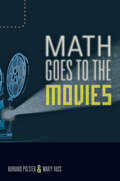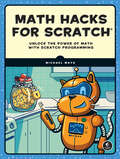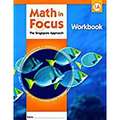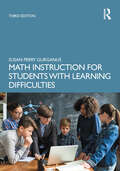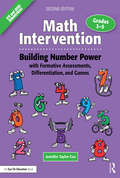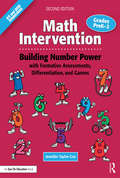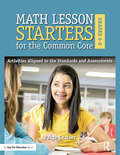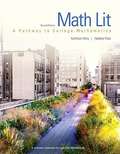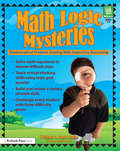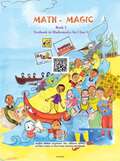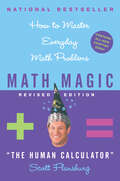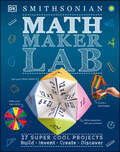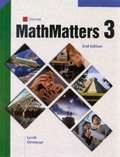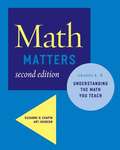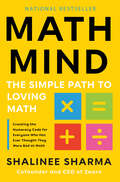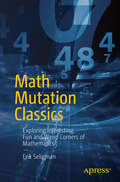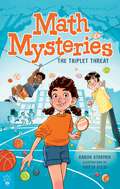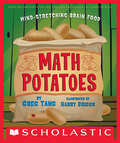- Table View
- List View
Math Goes to the Movies
by Burkard Polster Marty RossMel Gibson teaching Euclidean geometry, Meg Ryan and Tim Robbins acting out Zeno's paradox, Michael Jackson proving in three different ways that 7 x 13 = 28. These are just a few of the intriguing mathematical snippets that occur in hundreds of movies. Burkard Polster and Marty Ross pored through the cinematic calculus to create this thorough and entertaining survey of the quirky, fun, and beautiful mathematics to be found on the big screen. Math Goes to the Movies is based on the authors' own collection of more than 700 mathematical movies and their many years using movie clips to inject moments of fun into their courses. With more than 200 illustrations, many of them screenshots from the movies themselves, this book provides an inviting way to explore math, featuring such movies as:• Good Will Hunting• A Beautiful Mind• Stand and Deliver• Pi• Die Hard• The Mirror Has Two FacesThe authors use these iconic movies to introduce and explain important and famous mathematical ideas: higher dimensions, the golden ratio, infinity, and much more. Not all math in movies makes sense, however, and Polster and Ross talk about Hollywood's most absurd blunders and outrageous mathematical scenes. Interviews with mathematical consultants to movies round out this engaging journey into the realm of cinematic mathematics.This fascinating behind-the-scenes look at movie math shows how fun and illuminating equations can be.
Math Hacks for Scratch: Unlock the Power of Math with Scratch Programming
by Michael MaysPush Scratch programming to the limits as you explore primes, Fibonacci numbers, Pascal&’s triangle, and other mathematical curiosities through hands-on coding projects.If you&’re a student looking for project ideas to practice your math and coding skills, or a Scratch enthusiast just looking for something different, this is the book for you!Discover the exciting intersection of mathematics and programming with Math Hacks for Scratch®. This book is perfect for kids, educators, and programming enthusiasts eager to learn or teach math through fun, hands-on projects using Scratch, the popular visual programming language.You&’ll see how a little bit of planning, combined with the right mathematical or coding tricks, can make complex calculations doable. These are the &“hacks&” mentioned in the title. You&’ll write programs to speed up factoring big numbers, sort out a pizza party with Pascal&’s triangle, explore Fibonacci&’s famous sequence for counting rabbits, use cryptography to create unbreakable secret codes, and so much more.Inside, you&’ll find:Step-by-Step Projects: Learn how to create interactive games, animations, and simulations that bring math concepts to life. Convert between binary and decimal to see how computers keep track of numbers. Make sense of patterns in lists, sequences, and arrays. Encode cryptograms, unscramble secret messages, and crack the Caesar cipher.Real-World Applications: See how math is used every day to calculate probabilities in games and create dynamic graphics.Expert Guidance: Benefit from the insights of author Michael Mays, a seasoned math educator with a PhD in mathematics and a 40-year teaching career.Accessible Learning: Ideal for both beginners and experienced programmers, this book offers clear explanations and practical examples that make learning fun and easy.Whether you&’re a beginning coder wanting to enhance your Scratch skills, a teacher looking to inspire students, or a parent supporting your child&’s education, Math Hacks for Scratch provides the tools to turn coding projects into math adventures.
Math In Focus: 1A
by Great Source Education Group StaffMath in Focus: Singapore Math: Student Workbook, Book a Grade 1
Math Instruction for Students with Learning Difficulties
by Susan Perry GurganusThis richly updated third edition of Math Instruction for Students with Learning Difficulties presents a research-based approach to mathematics instruction designed to build confidence and competence in preservice and inservice PreK- 12 teachers. Referencing benchmarks of both the National Council of Teachers of Mathematics and Common Core State Standards for Mathematics, this essential text addresses teacher and student attitudes towards mathematics as well as language issues, specific mathematics disabilities, prior experiences, and cognitive and metacognitive factors. Chapters on assessment and instruction precede strands that focus on critical concepts. Replete with suggestions for class activities and field extensions, the new edition features current research across topics and an innovative thread throughout chapters and strands: multi-tiered systems of support as they apply to mathematics instruction.
Math Intervention 3-5: Building Number Power with Formative Assessments, Differentiation, and Games, Grades 3-5
by Jennifer Taylor-CoxHelp all of your students reach success in math! This essential book, from bestselling author and consultant Jennifer Taylor-Cox, is filled with suggestions that teachers and RTI/MTSS specialists can use to target instruction for struggling students in grades 3-5. You’ll learn how to diagnose academic weaknesses, differentiate instruction, use formative assessments, offer corrective feedback, and motivate students with games and activities. The book’s practical features include… Directions for incorporating formative assessments; Explanations of successful strategies for intervention; Important math terms to use with students; Games for active learning with printable boards; Cognitive demand questions ranging from easy to complex; and Rigorous problems to help you gather pre and post data. In this enhanced second edition, you’ll find correlations to the Common Core throughout, as well as a variety of brand new, rigorous problems designed to mirror those on CCSS assessments. Bonus! The book is accompanied by free eResources on our website, www.routledge.com/9781138915695. These eResources include an Answer Key with Scoring Guide and a handy Progress Monitoring Tool that you can use to track each student’s growth, record notes, and share data with parents, administrators, and other educators. The eResources also contain printable versions of the games in the book so that you can easily download and print them for classroom use.
Math Intervention P-2: Building Number Power with Formative Assessments, Differentiation, and Games, Grades PreK–2
by Jennifer Taylor-CoxHelp all of your students reach success in math! This essential book, from bestselling author and consultant Jennifer Taylor-Cox, is filled with suggestions that teachers and RTI/MTSS specialists can use to target instruction for struggling students in PreK-2. You’ll find out how to diagnose academic weaknesses, differentiate instruction, use formative assessments, offer corrective feedback, and motivate students with games and activities. The book’s practical features include… Directions for incorporating formative assessments; Explanations of successful strategies for intervention; Important math terms to use with students; Games for active learning with printable boards; Cognitive demand questions ranging from easy to complex; and Rigorous problems to help you gather pre and post data. In this enhanced second edition, you’ll find correlations to the Common Core throughout, as well as a variety of brand new, rigorous problems designed to mirror those on CCSS assessments such as the PARCC and SBAC. Bonus! The book is accompanied by free eResources on our website, www.routledge.com/9781138915626. These eResources include an Answer Key with Scoring Guide and a handy Progress Monitoring Tool that you can use to track each student’s growth, record notes, and share data with parents, administrators, and other educators. The eResources also contain printable versions of the games in the book so that you can easily download and print them for classroom use.
Math Lesson Starters for the Common Core, Grades 6-8: Activities Aligned to the Standards and Assessments
by Paige GraiserThe best way to prepare students for the Common Core State Standards in Math is through daily practice. This book provides engaging, practical lesson starters you can use each day to help middle school students become proficient in the complex mathematical thinking required by the Common Core. The lesson starters in this book are… reproducible and ready-to-use in the classroom; aligned with the five domains of the Common Core State Standards in Math; written to elicit the type of deep thinking that students need to succeed on the non-traditional PARCC and Smarter Balanced assessments; and powerful formative assessment tools to assist teachers in diagnosing student misconceptions so that daily lessons can be fine-tuned to meet the immediate learning needs of their students. Lesson starters not only aid instruction but also cut back on classroom management problems, since students get to work right when the bell rings. This book will help you engage students, save planning time, and bring all students to success in math!
Math Lit: Pathway To College Mathematics
by Kathleen Almy Heather FoesThis text provides a one-semester alternative to the traditional two-semester developmental algebra sequence for non-STEM (Science, Technology, Engineering, and Math) students. This new approach offers an accelerated pathway to college readiness through developmental math, preparing non-STEM students to move directly into liberal arts math or introductory statistics, while also preparing STEM students for intermediate algebra.
Math Logic Mysteries: Mathematical Problem Solving With Deductive Reasoning (Grades 5-8)
by Marilynn L. Rapp BuxtonStudents love trying to solve challenging puzzles. So why not build and review their math skills while they're having fun? Math Logic Mysteries requires students to complete math problems and use reasoning to unlock the clues needed to solve matrix-based logic problems. Mathematical skills covered include measurement, number operations, geometry, probability, fractions, decimals, percentages, and algebra. This book includes a detailed how-to section for teaching logic puzzles and an in-depth answer key, so students can understand the thinking process behind each solution. After doing these fun and challenging puzzles, your students will ask for more Math Logic Mysteries! Grades 5-8
Math Magic Semester-1 class 3 - Andhra Pradesh Board
by State Council of Educational Research and Training Andhra PradeshThe Class 3 Andhra Pradesh Maths Magic Semester 1 textbook is designed to enhance foundational mathematical skills in alignment with the latest educational standards and approaches. It introduces students to concepts through engaging, real-life contexts and activities such as shopping scenarios, games, and visual aids like abacuses and number blocks. Key topics include the number system, addition, subtraction, multiplication, and division, progressing from basic to advanced levels. Each chapter incorporates exercises to strengthen understanding, with sections like “Do these,” “Try these,” and “Exercises,” offering a mix of simple and challenging problems. The textbook also integrates QR codes for supplementary digital learning, fostering interactive and practical learning experiences. Teachers are provided with structured guidance to maximize classroom learning, emphasizing group, individual, and whole-class activities. Activities like creating numbers from digit cards or exploring patterns make learning enjoyable and contextual. Additionally, the textbook reflects a bilingual approach, making concepts accessible to all students. By blending mathematical theory with hands-on practice, the book aims to cultivate critical thinking, problem-solving skills, and logical reasoning in young learners while adhering to global educational standards. This textbook is a part of Andhra Pradesh’s initiative to ensure quality education and equip students with 21st-century skills.
Math Magic Semester-1 class 4 - Andhra Pradesh Board
by State Council of Educational Research and Training Andhra PradeshThe Class 4 Andhra Pradesh Maths Magic Semester 1 textbook continues to build on students’ foundational mathematical skills through a well-structured curriculum aligned with modern educational standards. Using relatable contexts like daily wage calculations, village scenarios, and practical applications, the textbook introduces key topics such as large numbers, addition, subtraction, multiplication, division, fractions, and measurement. Each chapter is designed with engaging components like “Do these,” “Try these,” and “Exercises,” progressing from simple to complex problems. Interactive activities such as forming numbers with digit cards, exploring geometric shapes, and visual representations on abacuses foster hands-on learning and critical thinking. QR codes provide access to digital resources for enhanced understanding. A bilingual approach ensures accessibility for all students, while teacher instructions emphasize collaborative and individual activities to reinforce learning. By combining theory with practical exercises, the textbook cultivates logical reasoning, problem-solving abilities, and mathematical fluency, aligning with Andhra Pradesh’s mission for quality education and holistic development.
Math Magic Semester-2 class 3 - Andhra Pradesh Board
by State Council of Educational Research and Training Andhra PradeshThe Class 3 Andhra Pradesh Maths Magic Semester 2 textbook builds on the foundational mathematical concepts introduced in Semester 1, continuing to enhance problem-solving and critical thinking skills. Aligned with modern educational standards, the textbook introduces topics such as multiplication, division, fractions, data handling, geometry, measurements, and the concept of time. Lessons are designed to relate math to daily life, using engaging contexts like sharing resources, playing games, and solving practical problems. Each chapter includes structured activities under sections like “Do These,” “Try These,” and “Exercises,” which cater to varying levels of difficulty, ensuring inclusive learning for all students. Real-life examples, visual aids, and interactive activities like tallying, dividing objects, and measuring items make learning dynamic and enjoyable. A bilingual approach (English and Telugu) ensures accessibility for a diverse student base. QR codes in chapters offer digital learning opportunities, promoting a blended learning experience. Teachers are guided with instructions to implement group, individual, and classroom-wide activities effectively. The book emphasizes hands-on exploration, fostering logical reasoning, collaboration, and creativity. As part of Andhra Pradesh’s educational reform, this textbook strives to deliver quality education and equip young learners with essential 21st-century skills while making mathematics fun and relatable.
Math Magic Semester-2 class 5 - Andhra Pradesh Board
by State Council of Educational Research and Training Andhra PradeshThe Class 5 Andhra Pradesh Maths Magic Semester 2 textbook is designed to build advanced mathematical skills in students while adhering to modern educational standards. It introduces topics such as geometry (points, lines, angles), fractions (types, addition, subtraction), data handling (bar graphs, pictographs), and measurements (length, area, perimeter, and volume). Lessons are crafted to relate mathematical concepts to real-life scenarios, using activities like drawing symmetrical patterns, measuring objects, and calculating with fractions. The book adopts a bilingual (English and Telugu) approach, making it accessible to a diverse audience. Engaging exercises and hands-on activities, including project work and QR-code-enabled resources, encourage interactive and practical learning. Structured guidance for teachers ensures effective lesson delivery, emphasizing group and individual tasks. This textbook aims to enhance logical reasoning, problem-solving, and analytical skills in students, aligning with global educational practices. It integrates fun and relevance, making mathematics enjoyable and applicable to daily life.
Math Magic class 5 - NCERT - 23
by National Council of Educational Research and Training"Math-Magic: Textbook in Mathematics for Class V," authored by the National Council of Educational Research and Training (NCERT) in India, is a comprehensive educational resource aligned with the National Curriculum Framework (NCF) 2005. The textbook, introduced by the NCERT Director in its foreword, aims to foster mathematical understanding and skills among fifth-grade students. With 14 chapters covering diverse mathematical concepts like shapes, angles, fractions, decimals, area, perimeter, multiplication, division, and measurement, each section offers a detailed explanation of core concepts, accompanied by engaging activities. The textbook's development involved a dedicated Textbook Development Committee comprising a chairperson, chief advisor, nine members, and a member-coordinator, along with an illustrations and design team. Notably, the inclusion of cut-out pages for interactive exercises enriches the learning experience, providing tangible tools like shapes, scales, and nets that can be manipulated to enhance comprehension and practical application of mathematical principles.
Math Magic: How To Master Everyday Math Problems
by Scott Flansburg Victoria HayNational Bestseller: “Tricks for performing accurate mental calculations and fun alternate approaches to common math class difficulties.” —Library JournalMillions of otherwise successful adults are afraid to balance their checkbooks and don’t know how to figure interest on savings or credit. Millions of students dread their math classes and live in fear of the math section of the SAT. But, as Scott Flansburg, “the human calculator,” demonstrates in this revised edition, anyone can put these phobias to rest and deal with essential everyday mathematical calculations with confidence!• Master the basics• The real way addition, subtraction, multiplication, and division work• Simplify calculations through estimation• Quick-check your answers• Convert metric measures to more familiar ones• Figure tips, taxes, and percentages—and never get shortchanged again!
Math Maker Lab: 27 Super Cool Projects (DK Activity Lab)
by DKA fun and engaging STEM activity book for kids that combines creativity and calculations - perfect for budding mathematicians!This is the perfect math exercise book for children interested in the STEM field. Choose between 27 creative projects and experiments that will turn your child into a math whizz! It's the perfect book for curious minds interested in taking the mystery out of math. Explore the exciting world of numbers and math problem-solving! In the pages of this math book for kids you&’ll discover: • 27 hands-on creative projects to engage reluctant mathematicians between the ages of 9-12 • Easy-to-follow step-by-step instructions will show you how to make each project • All materials used can be easily found around your home with no specialist equipment needed • Every project includes an explanation of how math is involved in creating the project or the results of the experiment • Real-world math projects show that math isn&’t just abstract - it has an impact in the real world too! Produced in conjunction with the Smithsonian Institution, SI Math Maker Lab is designed to appeal to math geeks and those that prefer practical projects. To complete these engaging projects, kids don&’t need to be math geniuses or even know how to use a calculator. Each task comes with easy-to-follow instructions, photographs, and illustrations to help whip up super cool mathematics creations!SI Math Maker Lab features interesting activities that cover many aspects of the subject including measurement, geometry, and trigonometry. Kids will combine art and math by learning to draw impossible objects - creating beautiful patterns to make things like a timetable dreamcatcher or perfect the ratio for making refreshing fruit drinks. Each project has an explanatory box that demonstrates how math is applied to the activity to demystify and make math fun!
Math Matters 3
by Chicha Lynch Eugene OlmsteadThis textbook is different from other math books because MathMatters combines mathematic topics in an integrated program. Number sense, algebra, geometry, statistics, and logic are presented as tools for investigating phenomena and exploring new math concepts. Each chapter has a theme. This theme is the focus of many application problems, the chapter career features, the chapter data activity and the chapter investigation.
Math Matters: Understanding The Math You Teach, Grades K-8, 2nd Edition
by Art Johnson Suzanne H. ChapinThis must-have resource is widely acknowledged for helping teachers, coordinators, and college faculty deepen their understanding of the mathematical concepts they teach. Math Matters provides an in-depth study with 14 chapters covering number sense, computation, addition, subtraction, multiplication, division, fractions, decimals, percents, ratios, algebra, geometry, spatial sense, measurement, statistics, and probability. Over 100 activities give readers an opportunity to connect ideas, compare and contrast concepts, and consider how students understand the mathematics presented.
Math Mind: The Simple Path to Loving Math
by Shalinee SharmaA national bestseller!Bust the math myths that are holding you and your kids back and learn the importance of numeracy with this one-of-a-kind resource for parents, educators, and policymakersShalinee Sharma is one of the world&’s top experts on math learning, but when she was in school, she sat in the back row, unsure if she could ever master the subject. Many of us buy into the idea that some people are innately good at math and others just won&’t ever succeed at it—but it&’s not true, and numeracy is as important as literacy when it comes to opening doors in life.Sharma shows how complex problem solving and puzzle solving, abstract and logical thinking, developing fluency with numbers, and cultivating persistence in math are crucial skills for success that can be taught to everyone and how math, far from being a dry, dull exercise, shares common ground with art and creativity. She also debunks the myths that prevent us from learning and enjoying math, with chapters dedicated to the three roadblocks that discourage adults and kids from learning.With instructive line drawings throughout, Sharma explains the math instinct that all humans have from birth, and better, more intuitive ways to solve math problems that are both rigorous and accessible. For anyone who has ever thought you&’re &“bad at math&” but wants to get good—for your children and for yourself—Math Mind contains the guidance, takeaways, and specific approaches you need to learn to love numbers.
Math Mutation Classics
by Erik SeligmanDid you know that sometimes 2+2 equals 5? That wheels don't always have to be round? That you can mathematically prove there is a hippopotamus in your basement? Or how to spot four-dimensional beings as they pass through your kitchen? If not, then you need to read Math Mutation Classics. This is a collection of Erik Seligman's blog articles from Math Mutation at MathMutation. com. Erik has been creating podcasts and converting them in his blog for many years. We have collected what we believe to be the most interesting among them, and have edited and organized them into a book that is often thought provoking, challenging, and fun. This book is about using math in unique ways; of analyzing things we observe in life and using proof to attain the unexpected. There is quite a wide diversity of topics here and so all age levels and ability levels will enjoy the discussions. Erik's unique viewpoint puts a mathematical spin on everything from politicians to hippos. Along the way, you will enjoy the different point of view and hopefully it will open you up to a slightly more out-of-the-box way of thinking. What you'll learn To look at different problems in a different manner Different ways of viewing the world How mathematics can be applied to things you thought unimaginable How to abstract things that are not taught in school Who this book is for The book is meant for teens to geezers. It is great for teenagers and college level students who can gain from the many different ways of looking at problems and feed their interest in mathematics. Even mathematicians will enjoy the twists of point of view this book projects. Finally, it is for anyone with a bathroom.
Math Mysteries: The Triplet Threat (Math Mysteries #1)
by Aaron StarmerA page-turning mystery brimming with lighthearted intrigue and essential middle-grade math skills, Math Mysteries: The Triplet Threat by author Aaron Starmer will have readers on the edge of their seats as they unravel the who-done it using math. Perfect for both mystery and math lovers, as well as kids who love puzzles, riddles, brainteasers, and adventure stories! It's the first day of the fourth grade at Arthimos Elementary and things are already off to a strange start--poisonous cookies, a zipline disaster, a missing iPad, and what are those strange sounds coming from the school custodian's wheelbarrow? Luckily the Prime Detectives--Abby “the Abacus” Feldstein, Cameron “Cam” McGill, and Gabriel “Gabe” Kim--are on the case! Using arithmetic, geometry, and logic, the Prime Detectives are sure to figure out who did what, when, and why! A gripping new middle grade mystery series, each book contains multiple, interlinked mysteries that readers help solve using math. Includes answers showing step-by-step solutions.
Math Nation Geometry 2017-2018
by Math NationWelcome to Math Nation! Our goal is to help you and all other students across Florida master Geometry. Geometry is essential for success in future math and science courses, on tests like the FSA End-Of-Course Exam, and in your future career (whatever it may be)! <p><p> WHAT IS MATH NATION? <p> 1. Videos and Workbook: Choose your Study Expert and watch them break down each topic as you follow along and mark up this workbook. <p> 2. Test Yourself! Practice Tool: Practice what you just learned with our Test Yourself! Practice Tool, available at the end of each section. Get immediate feedback on how you did and what you should focus on next. <p> 3. Geometry Wall: Have questions? Want to chat about math with other students across Florida in a safe, moderated, online environment? Go to the statewide Geometry Wall, where you can ask questions and receive help from other students, teachers, and our Study Experts. Study Experts will award Karma Points for helping other students. Top Karma Points earners will win prizes. Go to the Geometry Wall to learn more! <p> 4. Teacher Area: Teachers can view data for their classes in the Teacher Area, access extra resources, and collaborate with colleagues through the Teacher Wall. <p> Jump on Math Nation (by going to MathNation.com or downloading the free Math Nation app from your phone or tablet's app store) and get started!
Math Potatoes (Math Potatoes Ser.)
by Greg TangReaders who have graduated from THE GRAPES OF MATH will find new, more advanced math challenges.Greg Tang is back with his bestselling approach to addition and subtraction: problem solving. By solving challenges that encourage kids to "group" numbers rather than memorize formulas, even the most reluctant math learners are inspired to see math in a whole new way! Math Potatoes is full of Tang and Briggs' trademark humor, wit, and extraordinary creativity. Tang has proven over and over that math can be fun, and this new addition to his acclaimed series of mind-stretching math riddles is sure to be another hit.

